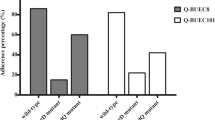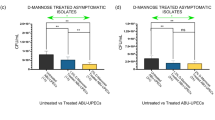Abstract
Studying the interaction between uropathogenic Escherichia coli (UPEC) and uroepithelial cells is important in elucidating the pathogenesis of urinary tract infection. In this study, the African green monkey kidney cells (Vero), human kidney carcinoma cells (Ketr-3) and bladder carcinoma cells (EJ) were infected by UPEC132, a clinical strain isolated from Tianjin, China, and were compared for their capacities to allow the adherence and invasion by this strain. The results revealed that all these cell lines could be attached and invaded by UPEC132. The adherence rates for Vero, Ketr-3 and EJ cells were (49.20 ± 7.55)%, (55.22 ± 4.09)% and (73.20 ± 5.26)%, respectively, and invasion frequencies were (2.61 ± 0.32)×10−3, (3.00 ± 0.34)×10−3 and (3.25 ± 0.20)×10−3, respectively. The statistical analysis showed that the adherence rate for EJ cells was significantly higher than those for the other two cell lines (P<0.05), and the invasion frequencies for EJ and Ketr-3 cells had no statistical differences (P>0.05) but were higher than that for Vero cells (P<0.05). Three cell lines were detected for the receptors for P pili of UPEC by using indirect immunofluorescence. The results showed that receptors existed on the surfaces of all cell lines, and the highest distribution was found on the surface of EJ cells. Additionally, the invasion of EJ cells by recombinant UPEC132/pSELECT-GFP could be directly visualized using confocal microscopy. These data strongly implicated that EJ cells could be more easily infected by UPEC132 than the other cells, and thus could serve as a good experimental target for further investigation of UPEC infection.
Similar content being viewed by others
References
Vaisanen V, Elo J, Tallgren L G, et al. Mannose-resistant haemagglutination and P antigen recognition are characteristic of Escherichia coli causing primary pyelonephritis. Lancet, 1981, 2: 1366–1369
Wullt B, Bergsten G, Samuelsson M, et al. The role of P fimbriae for Escherichia coli establishment and mucosal inflammation in the human urinary tract. Int J Antimicrob Agents, 2002, 19: 522–538
Emody L, Kerenyi M, Nagy G. Virulence factors of uropathogenic Escherichia coli. Int J Antimicrob Agents, 2003, 22(Suppl 2): 29–33
Gunther N W 4th, Snyder J A, Lockatell V, et al. Assessment of virulence of uropathogenic Escherichia coli type 1 fimbrial mutants in which the invertible element is phase-locked on or off. Infect Immun, 2002, 70: 3344–3354
Mysorekar I U, Hultgren S J. Mechanisms of uropathogenic Escherichia coli persistence and eradication from the urinary tract. Proc Natl Acad Sci USA, 2006, 103: 14170–14175
Xie B, Zhou G, Chan S Y, et al. Distinct glycan structures of uroplakins Ia and Ib: structural basis for the selective binding of FimH adhesin to uroplakin Ia. J Biol Chem, 2006, 281: 14644–14653
Brzuszkiewicz E, Brüggemann H, Liesegang H, et al. How to become a uropathogen: Comparative genomic analysis of extraintestinal pathogenic Escherichia coli strains. Proc Natl Acad Sci USA, 2006, 103: 12879–12884
Poljakovic M, Svensson L, Persson K. The influence of uropathogenic Escherichia coli and proinflammatory cytokines on the inducible nitric oxide synthase response in human kidney epithelial cells. J Urol, 2005, 173: 1000–1003
Schilling J D, Martin S M, Hunstad D A, et al. CD14- and Toll-like receptor-dependent activation of bladder epithelial cells by lipopolysaccharide and type 1 piliated Escherichia coli. Infect Immun, 2003, 71: 1470–1480
Hunstad D A, Justice S S, Hung C S, et al. Suppression of bladder epithelial cytokine responses by uropathogenic Escherichia coli. Infect Immun, 2005, 73: 3999–4006
Falzano L, Filippini P, Travaglione S, et al. Escherichia coli cytotoxic necrotizing factor 1 blocks cell cycle G2/M transition in uroepithelial cells. Infect Immun, 2006, 74: 3765–3772
Zheng L, Chen J Y, Chen Y K, et al. Cloning and sequencing of adhesin gene papG derived from uropathogenic Escherichia coli (in Chinese). Chinese J Zoonoses, 2002, 18: 34–38
Sambrook J, Fritsch E F, Maniatis T. Molecular Cloning: A Laboratory Manual. 2nd ed. Cold Spring Harbor: Cold Spring Harbor Laboratory Press, 1989
Birosova E, Siegfried L, Kmet’ova M, et al. Detection of virulence factors in alpha-haemolytic Escherichia coli strains isolated from various clinical materials. Clin Microbiol Infect, 2004, 10: 569–573
Bahrani-Mougeot F K, Buckles E L, Lockatell C V, et al. Type 1 fimbriae and extracellular polysaccharides are preeminent uropathogenic Escherichia coli virulence determinants in the murine urinary tract. Mol Microbiol, 2002, 45: 1079–1093
Das M, Hart-Van Tassell A, Urvil P T, et al. Hydrophilic domain II of Escherichia coli Dr fimbriae facilitates cell invasion. Infect Immun, 2005, 73: 6119–6126
Marcus D M, Kundu, S K, Suzuki A. The P blood group system: Recent progress in immunochemistry and genetics. Semin Hematol, 1981, 18: 63–71
O’Toole C M, Povey S, Hepburn P, et al. Identity of some human bladder cancer cell lines. Nature, 1983, 301: 429–430
Snyder J A, Lloyd A L, Lockatell C V, et al. Role of phase variation of type 1 fimbriae in a uropathogenic Escherichia coli cystitis isolate during urinary tract infection. Infect Immun, 2006, 74: 1387–1393
Holden N J, Totsika M, Mahler E, et al. Demonstration of regulatory cross-talk between P fimbriae and type 1 fimbriae in uropathogenic Escherichia coli. Microbiology, 2006, 152: 1143–1153
Martinez J J, Mulvey M A, Schilling J D, et al. Type 1 pilus-mediated bacterial invasion of bladder epithelial cells. EMBO J, 2000, 19: 2803–2812
Author information
Authors and Affiliations
Corresponding author
Additional information
Supported by the National Natural Science Foundation of China (Grant No. 30470096) and Specialized Research Fund for the Doctoral Program of Higher Education (Grant No. 20070062010)
Contributed equally to this work
About this article
Cite this article
Ge, X., Dong, J., Chen, J. et al. Comparison of infection of different cell lines by uropathogenic Escherichia coli . Chin. Sci. Bull. 54, 2662–2668 (2009). https://doi.org/10.1007/s11434-009-0389-7
Received:
Accepted:
Published:
Issue Date:
DOI: https://doi.org/10.1007/s11434-009-0389-7




